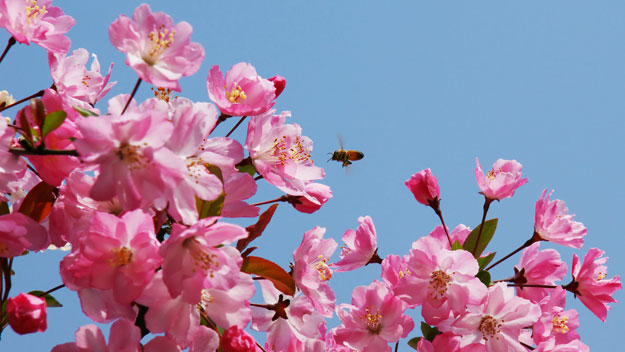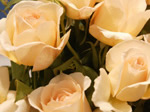The Japanese have a ceremony where they watch the first of the cherry blossom unfold. We watch our crab apple tree do the same thing — crab apple trees are hardier than a cherry tree and the blossom lasts longer in our harsher climate, too.
Every winter we watch the buds swelling, then suddenly in late August the first pink and white flowers open until the tree is a glorious mass of flowers, bees and birds.
Then every summer we discuss cutting the tree down, as it’s too close to the house and the leaves clog the gutters and cause drips indoors in summer storms. But we love it too much to let it go, even though I’ve planted many other crabs around the garden.
Crab apples are grown mostly for their stunning spring flowers. No other trees gives quite as much glory as the best of the crabs, like ‘Gorgeous’ (Malus x atrosanguinea ‘Gorgeous’), with its white flowers blushed with pink and small fruit covering the tree.
M. floribunda, the Japanese crab, is one of the most specular crabs, with deep pink buds opening to pink tinged white flowers so thick you can’t see the braches, followed by small fruit that can be used for jelly.
Bechtel’s Flowering Crab or M. ioensis ‘Plena’ is one of the largest bloomed crabs, with huge soft pink buds opening to semi-double pink white flowers, but it rarely sets fruit.
‘Eleyi’ or M x purpurea has deep pink-red flowers, and red foliage too. Its fruit is small and deep red, and hangs in attractive bunches, but again is too small to really bother with if you want crab apple jelly (but if you do decide to give it a go, the jelly is the most glorious deep red colour).
‘John Downie’ is one of the best ‘flowers and fruit’ varieties, with pink buds, large white flowers and orange red fruit.
The fruit of a few crab apples can be eaten fresh like ordinary apples, but basically the definition of a ‘crab apple’ as opposed to an eating apple is that they produce small, hard fruit.
Once the name ‘crab apple’ referred to wild apple trees with small fruit, but these days many of the crab apple varieties have been carefully bred to produce even more stunning and long-lasting flowers.
We have three varieties that can be eaten, one bought simply as ‘big red crab’ and the other as ‘big yellow’, while the third is an unnamed purple fleshed apple.
All three have single flowers — beautiful, but not nearly as spectacular as the ones grown simply for their blooms.
You’d be better off with the newly released ‘Tom Matthews’ crab, with vivid scarlet spring flowers, and clusters of dark red-purple fruits, or ‘Sutyzam Sugar Tyme’, if you can forgive it’s awkward name. It’s another new release, with massed pink white flowers, and small red crabs that hang even after the leaves have dropped in autumn.
‘Golden Hornet’ gives large, oval, bright yellow fruit ‘Wandin Pride’ is a weeping crab apple tree, and makes a superb ‘show off’ tree in the spring front garden.
Actually crabs can be stunning in autumn, too. Most have bright gold yellow autumn leaves, but a few, like M. trilobata and M. tschonoskii have striking red orange leaves. M. ioensis ‘Plena’ also has rich red and orange autumn foliage.
It’s very easy to fall in love with crabs. We had seven varieties at last count, all opening at slightly different times, so we have flowers from late August through to October, and a healthy crop of crab apples for what, with no modesty at all, are some of the best crab apple jellies around, ranging from deep red through pink to a glowing gold, depending on variety.
This year I threw several varieties of crab together, and the result almost glows from the bottle.
Crabs are drought resistant, once established — water and feed them well for the first three years, then ignore them.
They don’t need pruning to give stunning displays, and if you forget to pick the fruit the birds will do it for you. The fruit are usually too hard to get infected by fruit fly or codlin moth, though it can happen.
Crab apples are suitable in any area that gets light to heavy frosts each year. (If you wear sandals all winter, plant a jacaranda instead).
Some can grow very large indeed, others will have been grafted onto dwarfing stock and only grow about two metres, perfect for pots. But most crabs are naturally small, neat trees.
The only rules with crabs is not to plant it too close to the gutters, as they get clogged with leaves and fallen petals — same with swimming pools.
You should also avoid the very large fruited varieties in areas with bad fruit flies.
Otherwise crab apples are one of the most easy-care spectaculars for the garden — flowers in spring, followed by bright coloured fruit; a glory of autumn leaves than crab apple jelly all winter.
If I were starting my garden again, an avenue of crab apples would be one of the first things planted — all the same, for a couple of months of magnificence, with other crabs scattered around the garden to lengthen the displays and give me the joy of picking fruit you’ll never see in a supermarket.
When it comes to crabs, just go wild.
Jackie French’s crab apple jelly
This is one of the greatest of all jams and jellies, almost glowing in the jar. Different crabs will give slightly different jellies, some red, some pink, or orange or gold. It’s impossible to give accurate quantities, as the juiciness varies with the variety and the season.
You need:
Crab apples
Water
Sugar
Empty sterilised jars, with lids
A very large pot
Wooden spoon
Sieve
Large bowl
A clean cloth
Optional: mint leaves if you want to make mint jelly; dark red rose petals for rose and apple jelly; grated ginger for ginger jelly.
Method:
1. Place crabs (and any optional extras) in the pot. JUST cover with water. Simmer till tender. This can take half an hour or two hours. Mash a bit with the spoon.
2. Pour it all into the bowl, or several bowls if there’s too much for one. Suspend the sieve over the pot and line it with the cloth, then pour the crabs and liquid into the sieve. Don’t press down — let the clear juice drip into the pot overnight.
3. Next day, throw the crabby mess to the chooks, retaining the liquid. Measure the liquid in the pot. For every cup of liquid add 3/4 cup of sugar. Bring to the boil slowly, stirring so the sugar dissolves before it boils. It will rise up in the pot at first, then settle down and glop like a volcano. At this point it may be ready. Drip a little on a cold plate and push with your finger — if it wrinkles it should be right.
4. Turn off the heat, let it cool in the pot and see if it’s jellied. If not, cook for another five minutes and test again. If it gels, bring to the boil, then while still as hot as possible pour into the sterilised jars and seal at once. Store in a dark, cool place for at least six months and possibly a decade. Throw out if it changes colour or ferments.

